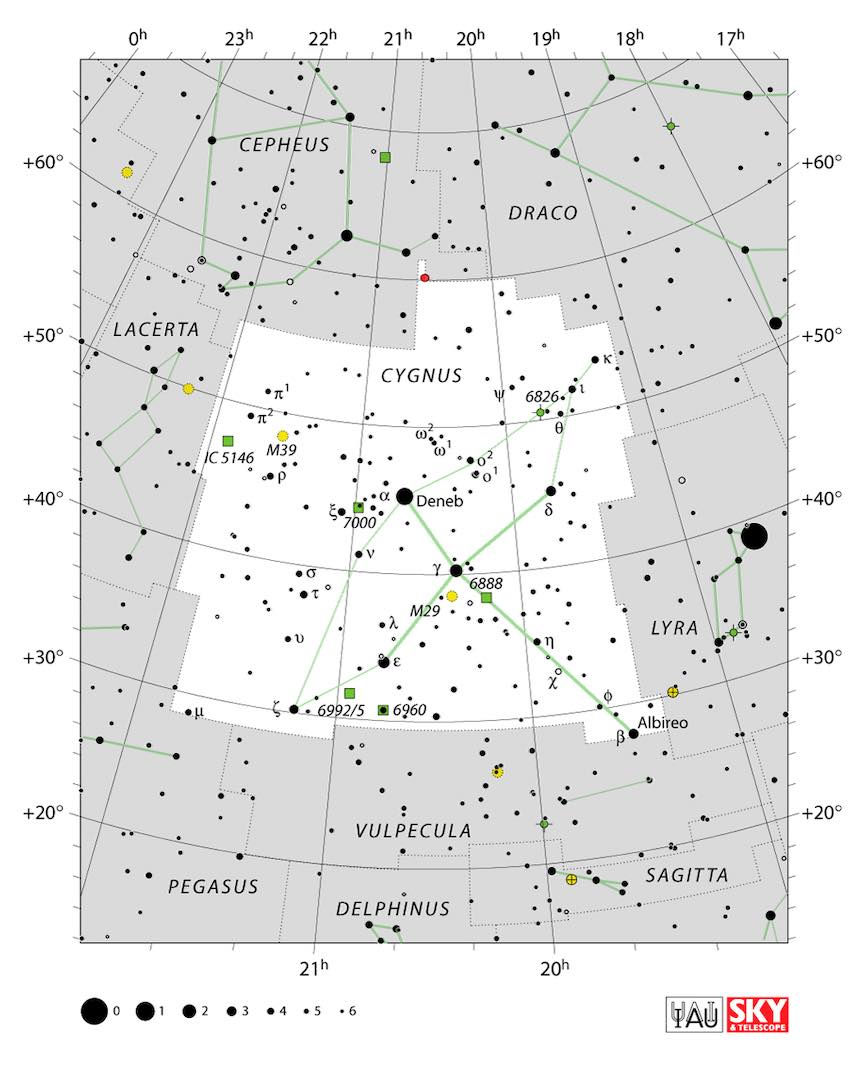Cygnus - Wide field Astrophotography of the Northern Cross Constellation
- Antoine & Dalia Grelin

- Dec 9, 2019
- 6 min read
Updated: May 19, 2023
Cygnus is one of the largest constellations in the night sky, and is very easy to find due to the brightness of its main stars. The brightest one, Deneb, is one of the three stars known for making the "Summer Triangle", the two other ones being Altair (from the constellation Aquila) and Vega (from Lyra). Cygnus represents a swan, and is often seen as the Northern Cross.
Cygnus Constellation Astrophotography
We decided to image Cygnus randomly while trying out the Omegon Mini Track LX2 as a star tracker. We were just done spending one hour on Rho Ophiuchi, and decided to try a constellation for the first time!
We only spent thirty minutes on it, as our goal here was to get the overall shape of the swan and the blanket of stars visible in that area. We plan to revisit Cygnus in the future and spend several hours on it to really capture the numerous nebulae it is home to.
Huge thanks to Benny Johnson for lending us his DSLR camera and allowing us to get this beautiful image!
30 minutes on Cygnus with a Canon 70D.

GEAR USED:
Camera: Canon 70D
Mount: Omegon Mini Track LX2
Processing: Pixinsight
ACQUISITION DETAILS:
Total Exposure Time: 30 minutes
Exposure Time per frame: 1 minute
30 lights, calibrated with Darks and Bias
ISO: 800
Cygnus with the main stars visible, click on the arrow for the outlines
How to find Cygnus?

Cygnus can easily be found high in the night sky during the Summer season, all the way until the end of Fall. To locate it, simply look for the three brightest stars forming the famous Summer Triangle (Altair, Deneb and Vega). You can quickly know if you are on the right star if you see that it is part of a large asterism resembling a cross.
Because Cygnus represents a swan, Deneb lies where the tail of the bird is, while Albireo is located at the neck of the animal. Both wings are easily recognizable as well.
Cygnus in Mythology
[As seen in The Constellations Handbook]
Phaethon, son of the sun god Helios, was a stubborn teenager who wanted to ride his father’s chariot so bad that he stole it. Despite his friend Cygnus’ disapproval, Phaethon rode the chariot into the sky, but quickly realized he wasn’t as strong as his father to control the two horses pulling it.
The chariot flew so uncontrollably that it started to burst into flames, the trail of smoke painting the night sky with the Milky Way band. The teenager then fell to his death in the river: Eridanus.

Cygnus discovered his friend’s body, trapped underwater, and begged zeus to transform him into a swan so that he could retrieve Phaethon and give him a proper burial. Cygnus was then placed into the night sky, in the middle of the fiery trail of smoke created by his friend’s flight, the Milky Way.
You can learn all about Cygnus and all 87 other constellations in The Constellations Handbook!
The 88 constellations are divided by groups, in the orders in which they interact with each other either in theme, mythology, or placement in the sky.
There are four main parts in the book, each part being linked to the astronomer who introduced them.
For each constellation, you will learn the stories associated with them, what deep sky objects can be seen in their vicinity, a map to find them in the night sky, if there are any meteor showers happening in them, our tips to remember them easily, and more!
What deep sky objects are located in Cygnus?
Cygnus contains several popular nebulae, such as the Veil Nebula, the North America Nebula, and the Pelican Nebula. You can also spot two Messier objects, M29 and M39, both being open star clusters. A few examples are shown below. Click on the images to read more about the target.
The North America Nebula
The North America Nebula (NGC 7000) is a very large emission nebula.
It got this nickname because of its shape which looks similar to the continent of North America.
One of the most famous parts of the North America Nebula is the Cygnus Wall, visible on our image near the bottom.
The Pelican Nebula
The Pelican Nebula is so close to the North America Nebula that it is visible in the NGC 7000 picture we posted above! Can you spot it?
We also imaged IC 5070 with a larger telescope, as you can see on the right. It is a beautiful target full of Hydrogen Alpha and Oxygen III gas. The Pelican Nebula is famous for its Herbig-Haro objects, structures of gas that create large jets when colliding with the surrounding nebulosity.
The Cygnus Loop
The Cygnus Loop, also known as the Veil Nebula Complex, is a supernova remnant made up of several different sections.
This area of the sky is either imaged wide field altogether or by photographing the different sections individually. On the left is our image of the whole complex.
The Cygnus Loop is composed of 3 main popular nebulae:
The Eastern Veil Nebula (NGC 6992)
The Western Veil Nebula (NGC 6960)
Pickering's Triangle (NGC 6974)
The Butterfly Nebula
The Butterfly Nebula is a colorful nebula located in an area of the sky completely full of gas known as the Sadr Region.
This picture shows a huge amount of colors and interacting gases, this was the first time we attempted to spend many nights for a single image, and ended up with 40 hours of data!
This is a lot of amateur astrophotographers' favorite part of the sky, as you can shoot anywhere around the bright star Sadr and get such amazing images full of gases.
Be sure to click the picture to see the high-resolution version.
The Crescent Nebula
The Crescent Nebula is close to Sadr, in the same overall area full of gases by the Sadr Region.
NGC 6888 looks like a brain and is sometimes referred to as a space brain. A much smaller and fainter nebula, the Soap Bubble Nebula, can be imaged next to the Crescent. It was discovered by an amateur astrophotographer in 2007.
Click the image to see the wider version!
Messier 39
Messier 39 is a beautiful open cluster that does not require a long total exposure time to look nice in pictures.
Our image on the right was taken in only one hour using a stock DSLR camera. M39 is one of the nearest clusters to Earth, after the Pleiades, the Beehive, and a couple of others.
Quick note about the Omegon Mini Track LX2
We used a small star tracker to capture this image, as we needed to take 60-second long exposures with our 50mm lens and did not want to use our bulky motorized mount at this location.
You can find our full review video of this tracker below, or read our written review by clicking HERE.
Final Thoughts
Although this was a quick test, as we only spent 30 minutes on it without any planning, we're glad we decided to give it a try! This motivated us to try capturing more constellations in the future. We'll edit this post when we get a better wide-field image of Cygnus.
Clear Skies,
Galactic Hunter
GALACTIC HUNTER BOOKS
Description: Discover 60 Deep Sky Objects that will considerably improve your Imaging and Processing skills! Whether you are a beginner, intermediate, or advanced astrophotographer, this detailed book of the best deep sky objects will serve as a personal guide for years to come! Discover which star clusters, nebulae, and galaxies are the easiest and most impressive to photograph for each season. Learn how to find each object in the night sky, and read our recommendations on imaging them in a quick and comprehensive way. Each target in this guide contains our advice on imaging, photos of expected results, and a useful information table. We've also included a few cool facts about each target, a map to find it in the night sky, and more!
Description: The Astrophotographer’s Journal is a portable notebook created for the purpose of recording observations, cataloguing photographs, and writing down the wonderful memories created by this hobby. This book contains more than 200 pages to memorialize your stargazing and imaging sessions, as well as a useful chart on the last pages to index exciting or important notes. Read back on the logs to see how much progress you have made through the months, the problems you overcame, and the notes taken to improve in the future. Just as the pioneers of astronomy did in their time, look up and take notes of your observations as you are the author of this star-filled journey.
Description: The Constellations Handbook is a logical guide to learning the 88 constellations. Learning the constellations is difficult. Remembering them is even harder. Have you ever wanted to look up to the night sky, name any pattern of stars and be able to tell their stories?This book groups the constellations in a logical order, so that the reader can easily learn them by their origin, and see how their stories interact with one another as a group.The last pages of this book include an index of all 88 constellations, each with a slot where you can write your own personal tips and tricks in order to memorize them with ease.The Constellations Handbook is not just another guide listing all the constellations from A to Z and their location, it is the perfect companion for stargazing, and a learning journey through the ages.





























Comments